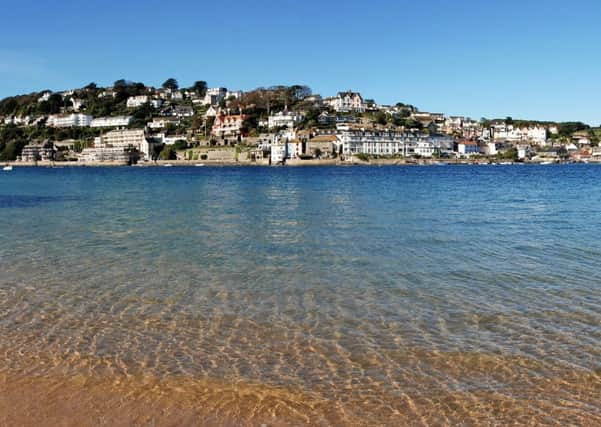Devon: Claws encounter


Nibbling on the delicate meat from a giant spider crab claw, with the sun shining down and a chilled glass of bubbles, I could be anywhere: Spain, Portugal, Italy. I’m not. I’m in Salcombe, a hidden Devon foodie haven I can’t believe I haven’t discovered before.
Salcombe has a reputation for being a playground for the rich, and has even been dubbed Chelsea-on-Sea. It was recently named the most expensive seaside spot in Britain to buy property, and is filled with second homes, whose owners flock to the coast for a relaxing weekend.
Advertisement
Hide AdAdvertisement
Hide AdI’m not surprised, because the attractions are many: stunning scenery, friendly people and freshly-caught, delicious seafood. And it’s this seafood we’ve come to try.
Rumour has it that 95 per cent of Salcombe’s red spider crab is shipped to Spain and France, where they can’t get enough of it, yet it remains relatively undiscovered in Blighty, where we tend to stick to its brown cousin.
Celebrating the area’s foodie roots, the Salcombe Harbour Hotel, which has recently undergone a £4m refurbishment, offers a Catch It, Cook It, Eat It package, allowing food lovers to try their hand at fishing and then transform their haul into a tasty feast.
So, armed with fishing rods, a good weather forecast, and a bucket-load of enthusiasm, we set out. Three hours later, we have caught two whiting and a herring. I’m not sure how Harbour Hotel chef Alex Aitken is going to feed us all, but he assures me: “We always have a contingency plan.”
Advertisement
Hide AdAdvertisement
Hide AdBack at the hotel’s Jetty Restaurant, we cluster round its rather grand crustacean bar to watch him prepare our fish into delicate morsels of tempura-coated fillets. Luckily, that’s just a tempting starter, and Alex has an emergency supply of additional seafood for us. We learn how to make paella and, of course, how to prepare the mighty spider crab.
Local fisherman Phil Cardew and wife Sarah, who run The Salcombe Fish Wife, which sells crab and lobster directly to the public at local farmers’ markets, tell me that many people are oblivious of the delights of this spindly beast.
Phil, who has been fishing around Salcombe for more than 11 years, says: “They were worthless at one time; people used to kill them, take them home and put them into their runner bean trench.”
But there’s more than just spider crab on the menu in this pretty town. Salcombe has a plethora of restaurants and brasseries. We move from meal to meal, sampling delights us landlubbers so rarely get to savour – well, not without wondering how long it’s been since the little blighter was in the sea.
Advertisement
Hide AdAdvertisement
Hide AdOne evening takes us to the stunning riverside terrace at Dick and Wills, a brasserie owned by father and son Richard and Will Bouverat. We’re in for a treat, feasting on a starter of spider crab three ways, followed by lobster thermidor.
Afterwards, as we can’t just eat seafood 24 hours a day, we take a stroll along the sunny South West Coast Path.
From Salcombe, we catch the ferry to South Sands beach, then haul ourselves up the steep hill to Overbeck’s Museum and Gardens.
Built in 1913, it was the seaside home of inventor and scientist Otto Overbeck, and his home went on to serve as a VA Hospital during the First World War.
Advertisement
Hide AdAdvertisement
Hide AdThe Edwardian house is now a National Trust property with subtropical gardens, and we enjoy the vistas from its vantage point on the cliff above Salcombe.
The meander back sees us stop at North Sands beach, home of The Winking Prawn, another of the area’s popular eateries.
Here the focus is on simple, good food for those who are seeking solace and relaxation.
As much as I enjoy fancy-pants food, there’s something equally charming about a pint of shell-on prawns and a portion of The Winking Prawn’s “popcorn shrimp”.
Advertisement
Hide AdAdvertisement
Hide AdWith our appetite for seafood temporarily sated, our attention turns to the other temptations on offer for foodie fans in the South West.
Just a stone’s throw from Salcombe is the South Devon Chilli Farm (SDCF), where rows of polytunnels produce 150 varieties of chilli, from jalapenos to the insanely hot Trinidad Scorpion.
At the SDCF, not only do they grow these little firecrackers, but they mix their own wide range of sauces, produce chilli chocolate and even have time to run a quaint cafe serving a range of chilli-based treats, including my new favourite – a savoury cream tea with rich cream cheese and sweet but spicy chilli jam.
An equally fascinating experience is the Sharpham Wine Estate. As we navigate a narrow country road, we’re rather sceptical about the prospect of English wine and cheese to rival our French neighbours. But we’re not disappointed.
Advertisement
Hide AdAdvertisement
Hide AdAs we round a bend, we’re greeted by dozens of tables outside, all filled with people sipping wine and enjoying fabulous-looking food.
With our guide Elke we enjoy an informal tasting, learning to appreciate the 13 different wines (including sparkling – turns out us Brits do bubbly as well as the French these days) in a casual setting, without any pressure to talk about noses, bouquets or tannins.
For the second time in a few days, I’m left wondering why I ever bother leaving Britain for my holidays.
• Ellen Branagh was a guest of the Salcombe Harbour Hotel (www.salcombe-harbour-hotel.co.uk) who offer the two-night Catch it, Cook it, Eat it experience from £599 per couple (or £65pp for a day trip for non-residents).
Advertisement
Hide AdAdvertisement
Hide AdSouth Devon Chilli Farm and Sharpham Vineyard offer tours throughout the year, while Dick & Wills, The Winking Prawn and South Sands Ferry are open seasonally.
Visit www.salcombeinformation.co.uk or call Salcombe Information Centre on 01548 843 927 to plan your escape.